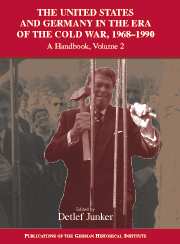Book contents
- Frontmatter
- POLITICS: Détente and Multipolarity: The Cold War and German-American Relations, 1968-1990
- SECURITY: German-American Security Relations, 1968-1990
- ECONOMICS: Cooperation, Competition, and Conflict: Economic Relations Between the United States and Germany, 1968-1990
- CULTURE: Culture as an Arena of Transatlantic Conflict
- 1 American Cultural Policy Toward Germany
- 2 The Third Pillar of Foreign Policy: West German Cultural Policy in the United States
- 3 The Study of Germany in the United States
- 4 American Studies in the Federal Republic of Germany, 1945-1990
- 5 In the Shadow of the Federal Republic: Cultural Relations Between the GDR and the United States
- 6 American Literature in Germany
- 7 The American Reception of Contemporary German Literature
- 8 The Americanization of the German Language
- 9 Between Blight and Blessing: The Influence of American Popular Culture on the Federal Republic
- 10 Popular Music in Germany: Experimentation and Emancipation from Anglo-American Models
- 11 Hollywood in Germany
- 12 New German Cinema as National Cinema
- 13 Transatlantic Reflections: German and American Television
- 14 Performance Theater in the Age of Post-Drama
- 15 Beyond Painting and Sculpture: German-American Exchange in the Visual Arts
- 16 The Rediscovery of the City and Postmodern Architecture
- 17 Modernity and Postmodernity in a Transatlantic Perspective
- 18 Confrontations with the Holocaust in the Era of the Cold War: German and American Perspectives
- SOCIETY: German-American Societal Relations in Three Dimensions, 1968-1990
- 1 “1968”: A Transatlantic Event and Its Consequences
- OUTLOOK: America, Germany, and the Atlantic Community After the Cold War
- Index
15 - Beyond Painting and Sculpture: German-American Exchange in the Visual Arts
Published online by Cambridge University Press: 05 January 2013
- Frontmatter
- POLITICS: Détente and Multipolarity: The Cold War and German-American Relations, 1968-1990
- SECURITY: German-American Security Relations, 1968-1990
- ECONOMICS: Cooperation, Competition, and Conflict: Economic Relations Between the United States and Germany, 1968-1990
- CULTURE: Culture as an Arena of Transatlantic Conflict
- 1 American Cultural Policy Toward Germany
- 2 The Third Pillar of Foreign Policy: West German Cultural Policy in the United States
- 3 The Study of Germany in the United States
- 4 American Studies in the Federal Republic of Germany, 1945-1990
- 5 In the Shadow of the Federal Republic: Cultural Relations Between the GDR and the United States
- 6 American Literature in Germany
- 7 The American Reception of Contemporary German Literature
- 8 The Americanization of the German Language
- 9 Between Blight and Blessing: The Influence of American Popular Culture on the Federal Republic
- 10 Popular Music in Germany: Experimentation and Emancipation from Anglo-American Models
- 11 Hollywood in Germany
- 12 New German Cinema as National Cinema
- 13 Transatlantic Reflections: German and American Television
- 14 Performance Theater in the Age of Post-Drama
- 15 Beyond Painting and Sculpture: German-American Exchange in the Visual Arts
- 16 The Rediscovery of the City and Postmodern Architecture
- 17 Modernity and Postmodernity in a Transatlantic Perspective
- 18 Confrontations with the Holocaust in the Era of the Cold War: German and American Perspectives
- SOCIETY: German-American Societal Relations in Three Dimensions, 1968-1990
- 1 “1968”: A Transatlantic Event and Its Consequences
- OUTLOOK: America, Germany, and the Atlantic Community After the Cold War
- Index
Summary
This chapter views artistic production from a sociological standpoint and interprets relations between Germany and the United States in the visual arts since the mid-1960s as one means by which national identities were constructed. This artistic exchange was crucial in dialogically formulating a national self-conception. In contrast to the arts exchange of the preceding phase, one dominated by the wholesale export of American art into West Germany, the period stretching from the mid-1960s to the mid-1980s was characterized by a sequentially evolving dialogue with shifting parameters. To capture the unique character of these years, we have divided them into three overlapping phases and focused on the diverse agents and mechanisms that determined this artistic exchange. Rather than resorting to an anachronistic interpretation of artistic activity as ideology - one either representing “interests” (the United States) or coping with “strain” (West Germany) - we investigate how cultural artifacts themselves embodied or constituted that interaction.
The institutionalization of American Pop art took place in West Germany during the late 1960s. The showcasing of this movement at documenta 4, as well as German collectors’ extensive purchases of works and a series of museum exhibitions initiated that year can all be seen as symptomatic of this process. Such developments mark a change in Pop art’s status, from being appreciated only within a restricted circle of artists and individual collectors – predominantly in Cologne and Düüsseldorf – to becoming a phenomenon with a wider public. This transformation expressed a structural shift in the West German art world involving changed attitudes and consequently institutions, creating the conditions for an extensive, albeit not altogether positive engagement with American art.
- Type
- Chapter
- Information
- The United States and Germany in the Era of the Cold War, 1945–1990A Handbook, pp. 379 - 386Publisher: Cambridge University PressPrint publication year: 2004



